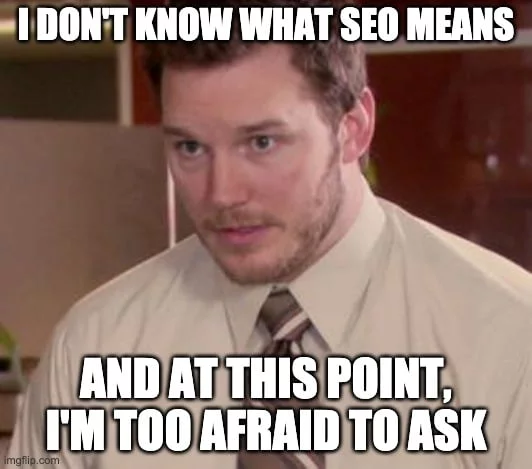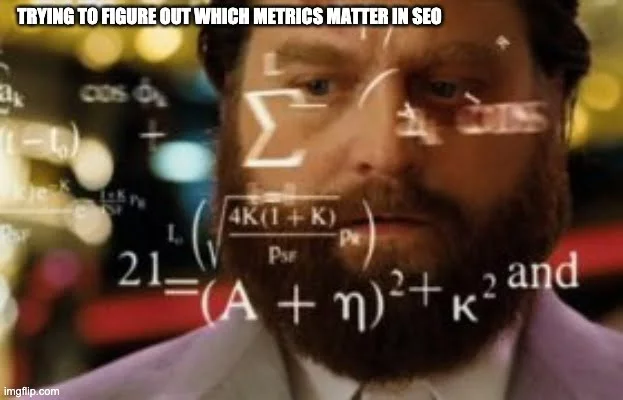By now, you’ve all probably heard about the importance of SEO in digital marketing. But why exactly are search rankings so crucial? And what metrics should you measure in your SEO reporting? Explore our guide to learn how to measure SEO performance.
It’s very easy to get bogged down in link building, meta descriptions, and the various other technicalities and factors of your SEO efforts. But how do you know you’re spending the right amount of time on each area?
In this guide, we’ll teach you:
- The most important metrics to keep track of in your SEO reporting.
- How to boost the crucial metrics and get conversions from SEO.
- How to measure and increase your ROI (return on investment) when it comes to search engine optimisation.
What’s the point in SEO?

Before we dive into specific metrics, it’s worth questioning why business owners and marketers ought to care about search engine optimisation in the first place…We know some of you may need convincing!
93% of all online traffic arrives through search engines, while 81% of people conduct online research before making a purchase. It helps to see search engines such as Google and Bing as gatekeepers of the web; the librarians of the biggest library in the world.
Now, you can either make these gatekeepers your friend by guiding them through your website via SEO tools and best practices, OR, you can sit idly by and hope they stumble upon you by chance. Spoiler alert, they won’t.
What are search engines looking for?
SEO is the act of making changes to your website and adopting practices to improve its visibility on search engines. Google rankings are determined by indicators of EAT:
- Expertise
- Authority
- Trustworthiness
If you can demonstrate all of these in your content marketing, your website will find its way to the top organic search results, and it won’t be long before you see a huge increase in free, organic traffic. So, to summarise:
SEO = More Search Engine Visibility = More Traffic = More Customers.
If you’re yet to start optimising your website for search engines, this guide is absolutely still worth reading. From here, you can begin to build your baseline.
Start SEO reporting now, before you get stuck into making changes, and you can then measure the significance of each improvement you make from here on out.
Once you’re clued up on SEO reporting, unlock several immediate changes you can make to improve your site’s SEO with our other guides:
- Keyword Research: The Pillar of SEO
- What are Backlinks & How Do They Help SEO?
- On-site SEO: How To Write Content That Ranks on Google
SEO Reporting: Conversion Metrics
The most important metric of them all: conversions. Everything you do with your marketing, including SEO, should have a measurable ROI, and this comes from conversions.

A conversion is an action completed on your website that fulfills a predetermined goal. This can include a prospect becoming a paying customer, or a new visitor becoming a prospect.
Examples of conversions you can set up for your website:
- A completed purchase.
- Someone filling out a contact form or downloading something.
- A user spending a certain amount of time on your site or visiting a certain number of pages.
- Someone clicking on your email or phone number.
- A new email newsletter subscriber.
- Someone arriving at your site via a search engine. There’s no reason why the initial aim of your SEO efforts shouldn’t be recorded as a conversion!
To keep track and measure conversions, you’ll need to login to your Google Analytics and set up Goal tracking.
Setting up Goals in Google Analytics
Google Analytics goals are the key to demonstrating the fruits of your labour.
For starters, you’ll need to follow this handy guide: How to set up Google Analytics Goals.
When creating a goal, make sure you assign a monetary value to it. This is how you measure your ROI.
If, for instance, your goal is to encourage people to sign up for a Free Trial of your software (which usually costs £100 a year), and you know that 50% of people who do so end up paying full price at the end of their trial and that the average user pays for the service for 3 years… The value of a Free Trial conversion would be £150. Here’s how we worked that out:
£100 (cost of software) x 0.5 (percentage of trialists who become paying customers) = £50 x 3 (average number of years someone pays for software) = £150.
How to measure SEO Conversion Metrics
If this is the first time you’ve set up your Goal(s), wait four weeks before returning to Google Analytics to measure conversions. This is when you can begin to accurately measure the overall success and outcome of your SEO efforts (tracking of a Goal will only take place after you’ve set the Goal up, it does not work retrospectively, unfortunately).
Click on Acquisition, followed by All Traffic and finally Channels.

From here, keep an eye on the following conversion metrics on the Organic Search row:
- Goal Completion - The key number. This is how many people have performed the very action you want them to complete.
- Goal Conversion Rate - The likelihood of conversion from the average session, a session being a “group of user interactions with your website that take place within a given time frame”.
- Goal value - This is arguably just as important, if not more so, than the Goal Completion metric. Why? Because the Goal Value essentially tells you the ROI on your SEO efforts.
If, for instance, you’ve generated £300 worth of goal value in the last four weeks, but you’re spending £800 a month on an SEO agency, all of a sudden that £300 does not look so impressive. On the other hand, if you’re only spending just a couple of hours a month on SEO, yet you’re generating £500 in Goal Value from those little tweaks, it’s safe to say you’re doing something right!
SEO Reporting: Awareness & Visibility Metrics
Now I know we’ve started with the most important set of metrics in this guide, but awareness and visibility are actually the first lines of attack when it comes to search engine optimisation.

If you look at your website’s SEO and the customer journey as a funnel, it would look something like this:
- Someone conducts a search on Google using your keyword or phrase. Let’s say they’ve searched: “How to build a shed”
- They click on your result and arrive on your blog, “How to build a shed in 5 simple steps”. Now, they are a prospect...
- They stay on your website and click on a few more pages. They read another blog on gardening, before heading to the shop subdomain of your site. They’re getting closer to converting.
- They arrive at your product page and purchase wooden panels and a toolbox to build their shed..
This path represents how SEO and expert content can generate prospects and turn them into paying customers/conversions. What we’re now going to focus on is those first two steps...
SEO Keyword Metrics
Keyword research is the pillar of SEO, increasing your site’s visibility on search engines and driving organic traffic to your domain.
If you look back at the four-step conversion journey above, your ability to rank for a keyword or phrase is your first chance to get noticed by potential customers.
It’s important you not only choose your target keywords and phrases wisely (think high search volumes, low difficulty/competition), but also that you optimise your content to show Google your page has the best solution to whatever problem or query the searcher has.
More information on this can be found in our Keyword Research Guide.
SEO Keyword Tools
To measure the effectiveness of your keyword planning, choices, and execution, you’ll need to use an SEO tool. We would strongly recommend SEMRush; this has almost everything you need to manage and improve your search engine optimisation.
If, however, you’d rather not pay for an SEO tool right now, we would suggest using Moz Keyword Overview, which gives you 10 free searches a month.
Using this tool to search for your root domain will tell you:
- The total number of keywords your site is competing for.
- The position of your site in the search engine results page for those search terms.
- The difficulty of ranking for each keyword (the level of competition).
- Search volume (how often users search for these specific keywords and phrases).
The last bullet point is an important one. It’s easy to get lost in the glitz and glamour of ranking on page one of the SERP (search engine results page), but if only 10 people a month are completing the search query you’re ranking for, it’s not much use to you.
Measuring Keyword Success
Context plays a key role in SEO reporting. When it comes to measuring keyword success, look for:
- What keywords your site is ranking for.
- Are they relevant to your content, products, and services?
- Do they signal purchasing intent?
- How many people are searching for these terms each month?
- What product pages or blog posts are they sending people to? How much traffic are they getting?
- What keywords are your competitors ranking for? Could you make improvements to your on-site SEO to outrank them?
Referral Traffic: Inbound Links
Referral traffic from other websites referring can certainly help you rank high on search engines, as Google sees inbound links as proof of trustworthiness and value, two factors it holds very highly.
How to measure the quality and number of backlinks and mentions
You can use a number of SEO tools to measure inbound links, but for the purpose of this guide, we’ll be using Moz Link Explorer, which gives users 10 free searches a month.
Once you’ve signed up for a free account, head to Link Explorer and search for your domain name. Ours, for instance, would be www.knaptonwright.co.uk.
After doing so, you’ll be able to analyse some of the websites linking to your own pages. The noteworthy metrics here are the number of links and the quality of the links. Ideally, you want both to be high.
Quality is measured by the Page Authority and Domain Authority of the sites linking to your own, while the quantity of links is measured by the sheer number of pages that link to your content.
If you would like to learn how to increase the number of inbound links to your site, check out our guide on how to get backlinks.
How to remove spammy links
Spammy links, aka links from websites that Google deems untrustworthy and potentially dangerous, can significantly damage your SEO performance.

While you can’t exactly prevent people from linking to your website, you can make sure that those links are not considered in rankings. To do this, you’ll need to create a Google Search Console account and disavow each spammy link.
SEO Reporting: Assessing the quality of your content
Always consider who you are writing for: user experience is key.
You are not producing content for Google; you are producing content for your audience. Your writing needs to, first and foremost, demonstrate value to your visitors.
Yes, specific pages need to be optimised so that your target market is able to find them via search engines, but if your content isn’t actually worth reading, people will leave your site moments after arriving onto it. Google obviously does not like this.
So, if you are driving people to your site via SEO, how do you then measure the effectiveness of your content?
Metrics you should be measuring to assess content
To analyse content quality on your website, head to Google Analytics and select Acquisition > All Traffic > Channels.
Here, you’ll need to measure the following behaviour metrics on the Organic Search row:
- Bounce rate: Bounces are single-page sessions on your site, therefore the bounce rate is the percentage of visitors who arrived onto your page, then exited your site without visiting another page.
You should be aiming for less than 70% here, but context does play a key role in these figures, of course. If the blog post or webpage in question is a simple landing page with very little calls to action, the bounce rate is going to be higher than a retail site with many products, for instance. - Pages/Session: The average number of pages each visitor explores after arriving onto your site. This is a key measurement of how engaging your website is. If a user is keen to visit more pages, they are more engaged in your brand, and therefore more likely to arrive onto the shop/product pages and convert.
- Avg Session Duration: Like the pages/session results, a session duration is another indicator of quality content. If a visitor spends time to learn more about your brand and what you have to say/offer, they are more likely to convert.
These metrics tell Google the value and quality of your content (which in turn helps you rank higher).
How to improve site engagement
To improve bounce rate, pages/session, and average session duration, make sure you...
- Place relevant calls to action in strong positions on your page to provide plenty of opportunities to learn more about your brand, products, services and blog posts within your site.
- Improve your site speed. If pages take a long time to load, people will not wait around.
- Use videos to keep people on your site longer and improve engagement.
- Maximise user experience on your site. Is your content readable and clear? Is it optimised for mobile devices?
- Enhance site navigation. Make it as easy as possible for visitors to jump from page to page.
- Look at what pages are performing best on your site and form a new content strategy around them.
Oliver Wilkinson
Content Manager
Get access to our complete SEO Library
Keyword research, search optimisation, content marketing, backlinks and more. Get everything you need to become an SEO expert!




